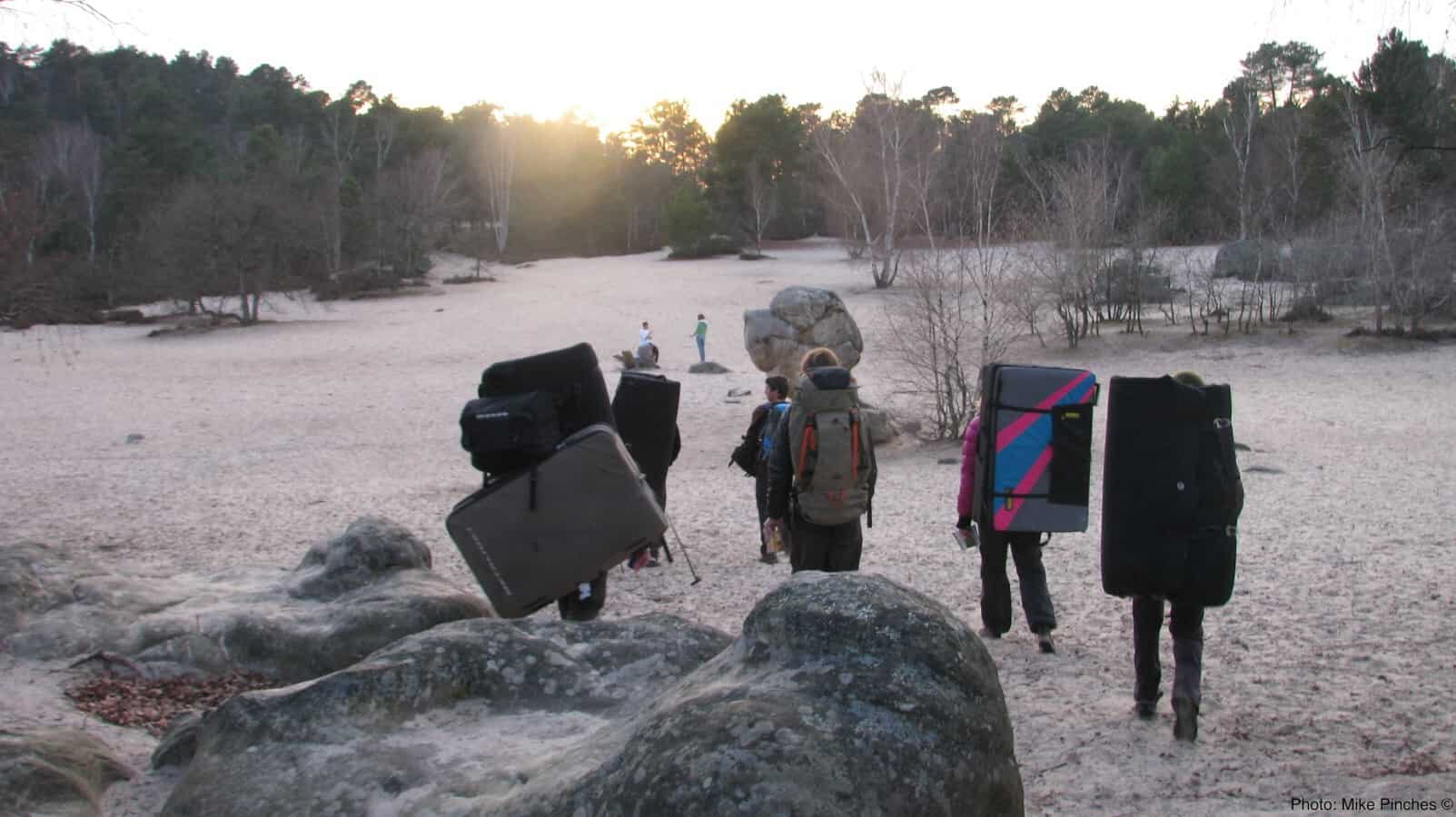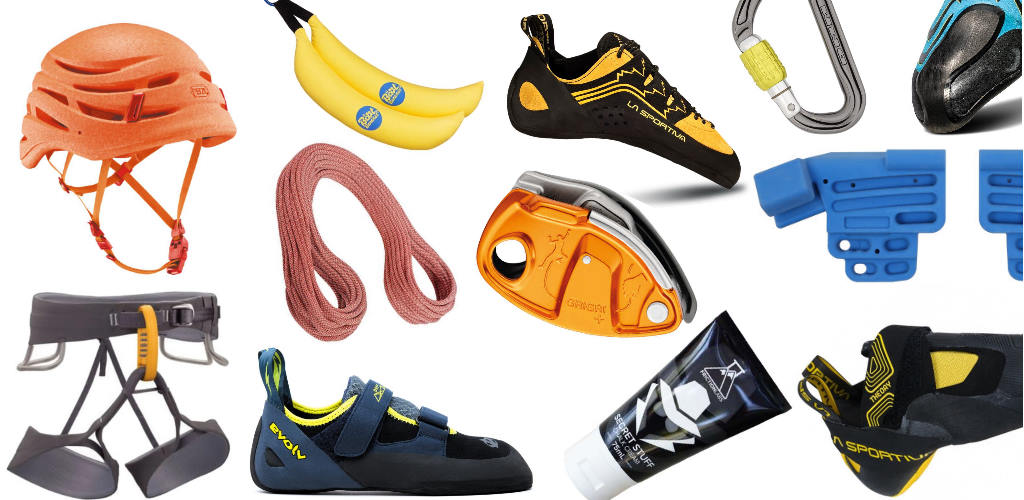Carabiners are a climber’s best friend. They’re used for so many things that their design has evolved to the point where there are specialist carabiners for almost every situation.
Without carabiners, modern climbing just wouldn’t be what it is today. The new technology changed what was possible by allowing climbers to clip a rope to protection while continuing to climb. This bit of climbing tech is now over 100 years old but still evolving to this day!
What Is A Carabiner?
A carabiner is a metal loop that closes with a gate. They are used in rock climbing to clip to a freely-moving rope, to build safety anchors, to attach safety gear to bolts or safety gear, and can be quickly clipped to a climbing harness. In climbing – carabiners are really used for everything.
Carabiners are sometimes described as climber clips or hooks – though climbers don’t really use these terms. They also come in a range of shapes: ovals, D, offset D, and HMS (pear-shaped) are all common. The gates can be made of tensioned wire or a solid piece of metal with a spring that snaps it shut. The gates can be non-locking or locking, with a few different methods for secure closure.

What Is A Carabiner Used For In Climbing?
Honestly, there are way too many uses of a carabiner to list them all. Here are just a few: –
Belaying & Rappeling
The belayer is the person on the floor who holds the climber’s rope to catch them when they fall. Instead of grabbing the rope with their hands, they use a belay device which creates friction in the rope to stop the drop. The most common belay devices are the GriGri and manual tube-style devices like an ATC.
You can belay with just the rope around a carabiner or two, which is attached to the belayer’s harness. These days almost everyone runs the rope through a belay device that is attached to the harness with a carabiner. An HMS carabiner is the most common belay carabiner because of its wide, pear-like shape.
Rappeling is coming down from the top of a wall. Again, you can rappel with just a couple of carabiners on their own but most people will use the same belay device to rappel down a rope. You can also use specialized rappel tools like a figure of eight.
Read up on our favorite carabiners
– Best Belay Carabiners
– Best Carabiner For GriGri
– How Many Quickdraws You Need
– How Strong Is A Climbing Carabiner?
Quickdraws
A quickdraw is two carabiners are attached by a short length of tough webbing. One side clips to a bolt or other protection in the rock face, then the climber’s rope is clipped through the other. As the climber goes up the rope runs through the carabiner freely. If the climber falls, their partner stops the rope with a belay device and the climber falls to just below the last quickdraw.
Clipping Rope Into Protection
When you trad climb, you bring things like cams and nuts to place in the rock to protect yourself from a fall. Once you’ve placed one, you’ll use a quickdraw or just a single carabiner to clip the rope to it.
Storing + Racking Gear
Trad climbers can take quite a lot of different sizes and styles of protection on a climb so they always have a piece that fits. All of this gear needs to be “racked” on a harness, and carabiners do the job perfectly. Climbers use different colored carabiners for different sizes of protection for easy picking.
You can also store an emergency kit on a single biner that’s always ready on a harness. It normally has a couple of prussiks, a spare sling, and something like a Micro Traxion in the case of an emergency. If your belayer gets knocked out by a falling rock, you get injured, or the rope gets damaged – there’s always a way to self-rescue.

Creating An Anchor
When a climber gets to the top of a rope and wants to bring their partner up or to set up a way for themselves to go down, they may create an anchor. There are many types of anchors but most involve clipping a few quickdraws into bolts or protection placed into the wall, then tying a rope to them or re-threading the rope through those carabiners.
Everything Else
Carabiners can also be used for hauling gear up a big wall (like the Dawn Wall), even setting up a few with a pulley for a more efficient 2:1 or 3:1 ratio system. In an emergency, climbers can use a quickdraw or carabiner to attach themselves directly to a bolt in a wall, or with a clove hitch knot on the rope straight into a carabiner.
Basically, carabiners are used everywhere, all the time in climbing. Most climbers have a variety of shapes and sizes of them just in case. The smallest climbing carabiners are as light as 19 grams!
Carabiners are also used in tonnes of other places. Boaters, high line workers, rigging crews, tree surgeons, and campers use a wide range of different carabiners for many reasons.
Carabiner Name Origin – Why Is It Called A Carabiner?
The carabiner’s name originates from around the 1600s. It’s a shortened form of the German word Karabinerhaken which translates directly to “carabinier’s hook”. This was a type of closing hook (an early version of a modern carabiner) used by soldiers to attach their carbine rifle to a strap they could sling around their shoulder.
The word karabiner or carabinier comes from various European spellings for soldiers armed with a carbine gun. Carbine also refers to the short-barreled rifle they used, so the word carabinier is similar to a rifleman or infantryman – a soldier with a specific weapon.
Carabiner History
Carabiners used in climbing were first made of steel around the 1890s in Germany and Austria. Initially, they were used to easily attach hammers and gear to the climber for easy access. There were no harnesses back then, just rope tied around the waist.
Early alpinists used pitons (thin metal spikes of various designs) that were hammered into the rock for protection. The first pitons had a ring in them to tie the rope to and were used not just to secure rope but as a form of aid to pull up on.

Who Invented The Carabiner?
The modern carabiner was designed by German climber Otto Herzog around 1910. Otto was nicknamed “Rambo” after the German word “Ramponieren”, which means “to batter/to bash”. The story is that he saw a form of the original steel, pear-shaped “karabiner” being used by the fire service.
He use a similar design and created the first carabiner made specifically for climbing. At the same time, his friend Hans Fiechtl also made the first one-piece piton with a hole pre-forged at the end. The thin, modern carabiner could now fit through the eyelet of the new piton. That meant lighter gear with more versatile uses.
These two bits of climbing technology were used to great effect by another German climber of the time: Hans Dülfer. He developed the “Dülfersitz” method of rappeling with a rope around the body, as well as early belay anchors, and a belay method using two carabiners.
Modern Carabiner Design
The design improved over the decades to be lighter and easier to use. Eventually in the 1930s aluminum carabiners were invented and in the 40s started to be mass-produced. These were lighter and easier to mold and most modern carabiners use this metal.
These days nearly all carabiners are made of an aluminum alloy with an anodized surface. This gives a smoother finish with leads to less friction and wear. It also reduces corrosion and rust by adding a protective layer. It’s easy to add a dye during the process of anodization, which helps for picking the right carabiner right when you need it.
Parts Of A Carabiner

- Frame – The main body of the carabiner
- Spine – The back of the carabiner, normally the strongest part
- Rope Basket and Crotch – The top and bottom parts of the carabiner respectively. Normally rope will sit in the basket and either rope, a dogbone (in quickdraws), a sling, or belay loop will go through the crotch end. A big basket is good for multiple ropes.
- Gate – The small metal length that opens like a gate. Can be solid, wire, locking, non-locking, straight, or bent.
- Locking Sleeve – The sleeve that covers the gate. In this diagram, it’s a screw gate sleeve that will cover the nose when locked, adding strength.
- Nose – The nose of the carabiner. Avoid nose hooking where the rope pulls on the notch here.
- Hook Notch or Latch – Where the top of the gate “latches” into the nose. Doesn’t need to be hooked and instead could be a “keylock”.
- Rivet Pin – A pin that is permanently fastened with a rivet. The gate opens along this axis. Wire gates are their own pins.
- Sling / Dogbone – Quickdraws have a sling joining two carabiners together. In sport climbing quickdraws, these are sewn tightly to one end of the carabiner. In trad draws these are looser and lighter.
- Rope Grooves – Many carabiners have slight divots or grooves already built into the carabiner. This guides the rope to the grooves which allow using the maximum rated strength of the carabiner.
- Gate Opening – The maximum opening is measured and noted for all carabiners. Helpful for knowing how easy it is to clip multiple ropes into a carabiner.
- Major Axis – When the gate is closed and the carabiner is pulled from the top and the bottom.
- Minor Axis – With the gate closed and pulled from side to side, much weaker.
Carabiner Pronunciation
The word carabiner is pronounced in a couple of different ways though both are understood anywhere. The first is the most technically correct but most people – in the US especially – use the second.
- ka – ruh – bai – nuh | The bi sounds like buy
- ka – ruh – bee – nuh | The bi sounds like bee
Slang Words For Carabiner
When you have to say this word multiple times in one sentence, you’ll want to shorten it pretty quickly. There is a tonne of different climber slang and carabiners have a few nicknames of their own: –
- Using “biner” (pronounced bye-nur) is probably the most common way. Pronouncing it with “bee” way sounds like a slur though, so try to use another term or use the “bai-nur” pronunciation. For example, “How many biners will we need for the anchor?“
- People also use “krab” (like crab). “How are those krabs working out for you?“
- “Clip” is a common one that generally refers to quickdraws – or the carabiner on a quickdraw. As in “Once you get past the fourth clip it’s a no-fall zone“
- “Snaplink” is an older term, but it checks out. “Snaphook” is similar, but refers more to a simplified snap-close hook that isn’t suitable for climbing.



